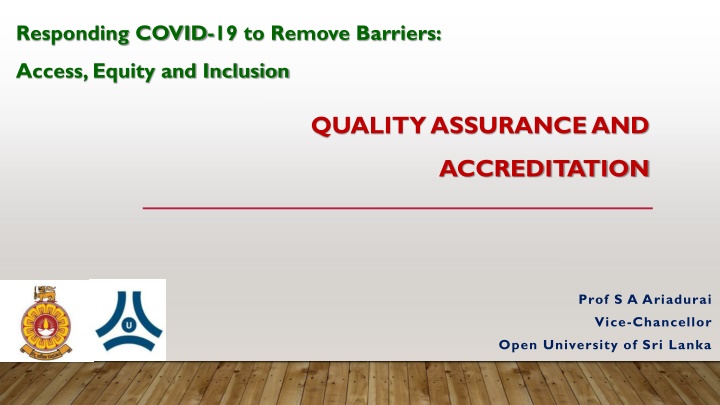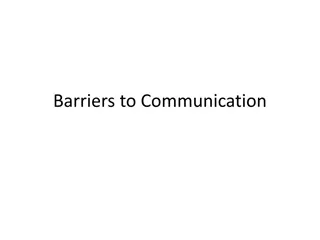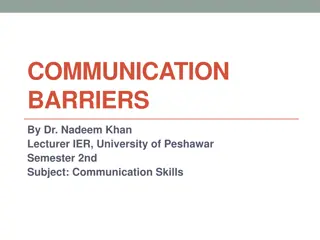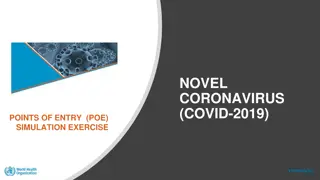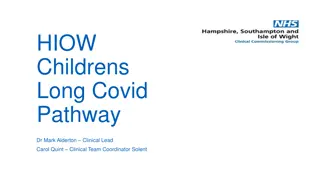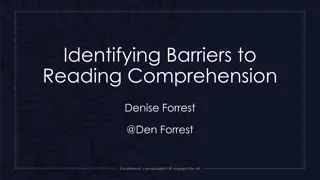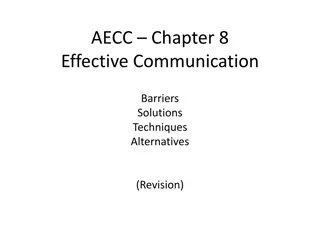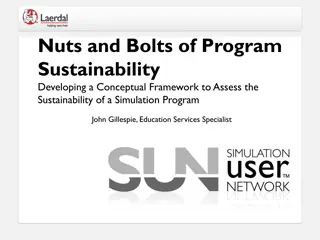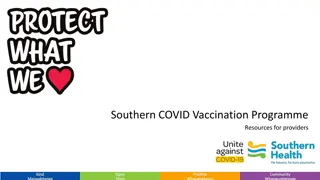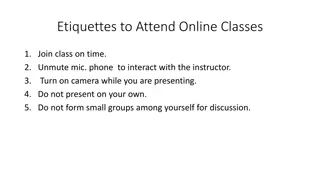Educational Response to COVID-19: Overcoming Barriers in Access and Learning
Global and Sri Lankan educational initiatives in response to COVID-19 focus on enhancing access, equity, and inclusion through various measures such as leveraging technology for distance learning, introducing online platforms, and promoting inclusive learning solutions. The prioritization of distance and online learning, along with the adoption of diverse online learning approaches like Emergency Remote Teaching, highlights the efforts to ensure uninterrupted education during the pandemic.
Download Presentation

Please find below an Image/Link to download the presentation.
The content on the website is provided AS IS for your information and personal use only. It may not be sold, licensed, or shared on other websites without obtaining consent from the author.If you encounter any issues during the download, it is possible that the publisher has removed the file from their server.
You are allowed to download the files provided on this website for personal or commercial use, subject to the condition that they are used lawfully. All files are the property of their respective owners.
The content on the website is provided AS IS for your information and personal use only. It may not be sold, licensed, or shared on other websites without obtaining consent from the author.
E N D
Presentation Transcript
Responding COVID-19 to Remove Barriers: Access, Equity and Inclusion QUALITY ASSURANCE AND ACCREDITATION Prof S A Ariadurai Vice-Chancellor Open University of Sri Lanka
Global Educational Response To Covid-19 Global Coalitions Global education coalition of UNESCO International Partnership of Distance and Online Learning for COVID-19 of COL Technical Assistances To quickly prepare and deploy inclusive distant learning solutions, utilizing hi-tech, low-tech and no-tech approaches Webinars Digital Learning Resources National Learning Platforms 2
Sri Lankan Educational Response To Covid-19 Two (02) National TV Channels dedicated for educational programmes Introduced MS Teams for Distance Learning in 1,030 (10%) schools island-wide Free access to servers in the LEARN network for all users UGC circular to integrate up to 25% online learning in regular programmes New entrants to conventional universities to be enrolled immediately using online education Lanka Education And Research Network (LEARN) is the National Research and Education Network of Sri Lanka, which interconnects Educational and Research institutions across the country, and provide network related services to them.
Priority to Distance and Online Learning A new state Ministry on Educational Reforms, Open Universities and Distance Learning Promotion Presidential Task Force on Educational Services with a mandate to Introduce and implement strategies to conduct student education activities without interruption under the distance education concept during this time period Formulate a programme to expedite new enrollments to universities and expand higher education opportunities by extending distance learning opportunities to such students as well
Online Learning Approaches During Covid-19 Online Course Delivery (OCD) Traditional approach Emergency Remote Teaching (ERT) Recent (Covid19) Term ERT coined by Charles Hodges, Stephanie Moore, Barb Lockee, Torrey Trust and Aaron Bond (2020), The Difference between Emergency Remote Teaching and Online Learning, EDUCASE review
Online Course Delivery (OCD) Courses, teaching and learning activities are conducted online via a Learning Management System (LMS) Moodle, Blackboard, Canvas, etc.
Emergency Remote Teaching (ERT) Use of online video conferencing tools for remotely delivering teaching lessons in real-time Google Meet, Jio-Meet, Big Blue Button, MS Teams, Zoom, etc. Likely to become a mainstream online teaching tool
Emergency Remote Teaching (as currently practiced) is not Online Course Delivery Online Course Delivery is an LMS platform-based delivery of an entire course or a part of a course Emergency Remote Teaching is an online channel for delivering a lecture In future, ERT (may be with a new defined term) can become one of the methods to transmit teaching contents on OCD already @OUSL
Issues with ERT (In Sri Lanka and World over during Covid-19 Pandemic ERT is Practiced) It works in the context of social distancing, especially when universities and teachers are not ready for ODC, though .. Learners may feel ready and interested with 1 or 2 subjects per semester, but It will not be comfortable to be online, in front of a computer and listen to 8 to 10 lectures a week
Quality Issues with ERT / Online Learning Many technologies but lot of difficulties Extended online learning is boring and unengaging Issues with personal attention Minimal interaction Many a times online content is theoretical and does not let students practice and learn effectively
Quality Issues with ERT / Online Learning Mediocre course content Lack of community, technical problems, and difficulties in understanding instructional goals are major barriers for online learning Lack of e-learning competencies and academic-type competencies among teacher and students Low-level of preparedness among students and teachers concerning the usage of LMS
Perceptions on Online Learning In many countries around the world, perceptions persist that online education is a second-rate, cheap, low quality option It is often associated with high dropout rates poorly regarded institutions unaccredited degree mills Combined with lack of understanding of advances in technology and associated pedagogy, these perceptions lead to a general distrust of online education Quality Assurance of Online Course Discussion Paper, Australian Government Department of Education and Training, 2017, https://tech.ed.gov/files/2018/11/APEC-Quality-Assurance-of-Online-Learning-Discussion-Paper-AUS-3.pdf
Necessity of Quality Assurance in Online Learning As online learning becomes mainstream, quality assurance is necessary To promote confidence in the quality and validity of online learning To address student mobility, employability, and labour demands within economies Students need to be satisfied that their investment in online education will be recognized Quality Assurance of Online Course Discussion Paper, Australian Government Department of Education and Training, 2017, https://tech.ed.gov/files/2018/11/APEC-Quality-Assurance-of-Online-Learning-Discussion-Paper-AUS-3.pdf
What is Quality? In case of goods and services, the general definitions of quality includes: Product-based definition (objective and measurable) User-based definition (customer satisfaction oriented) Manufacturing-based definition (subject to fixed input requirements and specifications) Value-based definitions (in relation to cost) Transcendent definition (subjective, personal and beyond measurement) In the case of education, first four types of definitions cannot be applied at all Emon Nandi and Saumen Chattopadhyay, Quality, Accreditation and Global University Ranking Issues before Indian Higher Education, India Infrastructure Report, 2012
Quality in Education Education is an experience good and thus except the student no one else can judge the quality of education provided in a university The university authorities may have an idea about the quality of education provided in their institutions, but not all of them may be interested in making the information public Unlike in a market for normal goods, price in education fails to reveal information about quality since the provision of education is largely subsidized. As the price of education is not market-determined, quality fails to be captured through price Emon Nandi and Saumen Chattopadhyay, Quality, Accreditation and Global University Ranking Issues before Indian Higher Education, India Infrastructure Report, 2012
Conceptualization of Quality in Higher Education No specific definition about quality assurance in higher education Quality can be viewed from stake-holders point as Accountable Purposeful Exceptional Transformative Schindler, L., Puls-Elvidge, S., Welzant, H., & Crawford, L. (2015). Definitions of quality in higher education: A synthesis of the literature. Higher Learning Research Communications, 5(3), 3-13. http://dx.doi.org/10.18870/hlrc.v5i3.244
Strategical Conceptual Model of Quality for Stake Holders Purposeful Accountable Exceptional Transformative Accountability to stakeholders for the optimal use of the resources and delivery of accurate educational products and services with zero defects Conformance to a stated Vision / Mission or set of standards including those defined by accrediting and/or regulatory bodies Positive change in student learning (affective, cognitive, and psychomotor domains) and personal and professional potential Achievement of distinction and exclusivity through the fulfilment of high standards Student preparedness for employment Procurement of quality resources Sufficiency of facilities Focus on continuous improvement Fulfillment of Vision & Mission Transparent aim & Processes Achievement of standards Attainment of institutional goals Credibility Legitimacy Reputation Ranking Prestige Learner centered approach Competency of teachers Clarity of outcomes Development of critical thinking Student engagement with content Schindler, L., Puls-Elvidge, S., Welzant, H., & Crawford, L. (2015). Definitions of quality in higher education: A synthesis of the literature. Higher Learning Research Communications, 5(3), 3-13. http://dx.doi.org/10.18870/hlrc.v5i3.244
Quality Assurance Systems in Higher Education Haruni Machumu,Sipora H. Kisanga, Quality Assurance Practices in Higher Education Institutions: Lesson from Africa, Journal of Education and Practice, 2014, https://www.semanticscholar.org/paper/Quality-Assurance-Practices-in-Higher-Education-Machumu-Kisanga/fc6d1b3b56966c9f320d9ebaae56d092a7dd71fe
Quality Assurance Practices in Higher Education: Levels International INQAAHE, ENQA, APQN National QAAC SL, NAAHE, NAAC Institutional IQAC, CQA
Quality Assurance in Higher Education: Traditions Systems with QA units within education authorities National bodies of Accreditation Regional Accreditation Associations International accrediting bodies Specialized and Professional accreditation Strong tradition of institutional autonomy Peter J. Wells, The Role of Quality Assurance in Higher Education: Challenges, developments and trends UNESCO Regional Meeting on QA Moscow, Russian Federation April 23-24, 2018
International Quality Assurance Agencies The US based Council for Higher Education Accreditation (CHEA) International Quality Group (CIQG) The International Network for Quality Assurance Agencies in Higher Education (INQAAHE) is a world-wide association of over 200 organizations active in the theory and practice of quality assurance in higher education.
Regional Quality Assurance Agencies 1. Arab Network for Quality Assurance in Higher Education (ANQAHE) 2. ASEAN Quality Assurance Network (AQAN) 3. Asia-Pacific Quality Network (APQN) 4. Association of Quality Assurance Agencies of the Islamic World (AQAAIW) 5. Caribbean Area Network for Quality Assurance in Tertiary Education (CANQATE) 6. Central and Eastern European Network of Quality Assurance in Higher Education (CEENQA) 7. Central Asian Network for Quality Assurance and Accreditation (CANQA) 8. CCE - Commonwealth Consortium for Education https://www.icde.org/knowledge-hub/quality-agencies
Regional Quality Assurance Agencies 9. European Alliance for Subject-Specific and Professional Accreditation And Quality Assurance (EASPA) 10. European Association for Quality Assurance in Higher Education (ENQA) 11. IEA - International Association for the Evaluation of Educational Achievement 12. European Consortium for Accreditation (ECA) 13. Red Iberoamericana para la Acreditaci n de la Calidad de la Educaci n Superior (RIACES 14. Agencia Nacional de Evaluaci n y Acreditaci n de la Educaci n Superior (ANEAES) 15. Quality Assurance Network for African Higher Education (AfriQAN) https://www.icde.org/knowledge-hub/quality-agencies
AAOU Initiatives Executive Committee of the AAOU appointed an Accreditation Task Force in 2017 Many consultation meetings (in person and online) held including expanded experts Task Force decided to develop an Accreditation System for Quality Assurance of Technology-Enhanced Higher Education in Times of Openness in the Digital Age of Technological Disruptions In Final stages of drafting the AAOU Accreditation Instrument to be pilot tested soon
AAOU Institutional Accreditation (Proposed) - Scope Proposed accreditation system of AAOU will take cover quality of Open Distance Learning Distance Education Technology-mediated Education, and Technology-enhanced Education
AAOU Institutional Accreditation (Proposed) Proposed accreditation system of AAOU will include Three (03) dimensions Four (04) levels Ten (10) criteria Several sub-criteria
AAOU Institutional Accreditation (Proposed) - Dimensions Agility - flexibility, responsiveness, adaptability, timeliness, relevance Equitability - comprehensiveness, inclusiveness, impartiality, fairness, accessibility Sustainability - consistency, resiliency, innovativeness, progressiveness. creativity
AAOU Institutional Accreditation (Proposed) Levels Use, creation and sharing of open distance learning, distance education, LEVEL 4 100% technology-mediated education, and technology-enhanced education Use and Creation of open distance learning, distance education, technology- LEVEL 3 75% - 99% mediated education, and technology-enhanced education Application/Use of open distance learning, distance education, technology- LEVEL 2 50% - 74% mediated education, and technology-enhanced education Awareness of open distance learning, distance education, technology- LEVEL 1 1% - 49% mediated education, and technology-enhanced education
AAOU Institutional Accreditation (Proposed) Criteria 1. 2. 3. 4. 5. 6. 7. 8. 9. 10. Course Design and Development Policy and Planning Internal Management Learners and Learners' Profiles Infrastructure, Media, and Learning Resources Learner Assessment and Evaluation Research and Community Services Human Resources Learner Support Program Design and Curriculum Development https://www.aaou.org/quality-assurance-framework/
University Rankings Ranking of global universities has become much popular these days, it has started influencing national policy-making in the case of education Times Higher Education Supplement (THES) World University Ranking QS World University Ranking Academic Ranking of World Universities (ARWU) ranking Webometrics Ranking U-Multi Ranking (European) In many countries in Asia experts, academics and policy-makers often express serious concern that our universities are not in the list of these rankings
Issues of Concern for Global University Rankings Reputational Ranking: Most rankings are based on popular perception of reputation. Thus, have an inherent bias for universities with academic reputation and influential position Teaching versus Research: Not all the global university rankings provide a holistic assessment of a university Bias in favour of Science Streams and English-Speaking Nations International Outlook: Assign a large weight to the proportion of international students and staff Threat of Losing Diversity in World Education System Emon Nandi and Saumen Chattopadhyay, Quality, Accreditation and Global University Ranking Issues before Indian Higher Education, India Infrastructure Report, 2012
Academic Ranking of World Universities - Top 100 Country and Faculty wise Statistics Emon Nandi and Saumen Chattopadhyay, Quality, Accreditation and Global University Ranking Issues before Indian Higher Education, India Infrastructure Report, 2012
Purpose of Accreditation and Ranking For Students Assures that quality of education imparted by an institution conforms to the well- defined standards set by the regulatory authority Helps to choose courses and institutions on the basis of grades or ranks obtained For the Institute Helps to know how they fare and to identify the gaps in their delivery mechanism Encourages the HEIs to put in an extra effort and improve their ranking.
Final Remarks Quality Assurance in Higher Education will only be meaningful if . it understands that education is very different from other marketable products, as it does not have a production function, fixed input-output relationship and quantifiable characteristics it recognizes that education imparts value to the society and therefore quality assurance should appropriately reflect the same it realizes that quality is not homogeneous across institutions and nations, and thus mechanism should consider different societal contexts and diverse missions, visions, goals, and objectives of various universities in assessing quality of education
Quotes of Wisdom An examination of a knife would reveal that its distinctive quality is to cut, and from this we can conclude that a good knife would be a knife that cuts well Aristotle What is important in knowledge is not quantity, but quality. It is important to know what is significant, what is less so, and what is trivial Leo Tolstoy
V A N A K K A M Thank You! June 1 3, 2021
